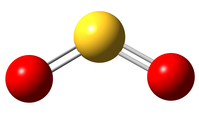Sulfur dioxide, 33S isotopomer
 | |
|---|---|
| Species tag | 065501 |
| Version | 1 |
| Date of Entry | Dec. 1999 |
| Contributor | H. S. P. Müller |
|
The measured transition frequencies were taken from
the compilations of | |
| Lines Listed | 19067 |
| Frequency / GHz | < 3451 |
| Max. J | 78 |
| log STR0 | -8.0 |
| log STR1 | -6.5 |
| Isotope Corr. | -2.119 |
| Egy / (cm-1) | 0.0 |
| µa / D | |
| µb / D | 1.6331 |
| µc / D | |
| A / MHz | 59856.479 |
| B / MHz | 10318.298 |
| C / MHz | 8780.139 |
| Q(300.0) | 23882.871 |
| Q(225.0) | 15501.843 |
| Q(150.0) | 8433.669 |
| Q(75.00) | 2982.020 |
| Q(37.50) | 1055.834 |
| Q(18.75) | 374.621 |
| Q(9.375) | 133.439 |
| detected in ISM/CSM | yes |